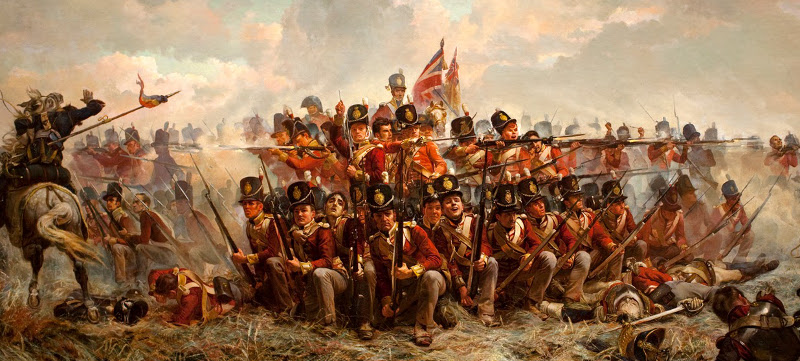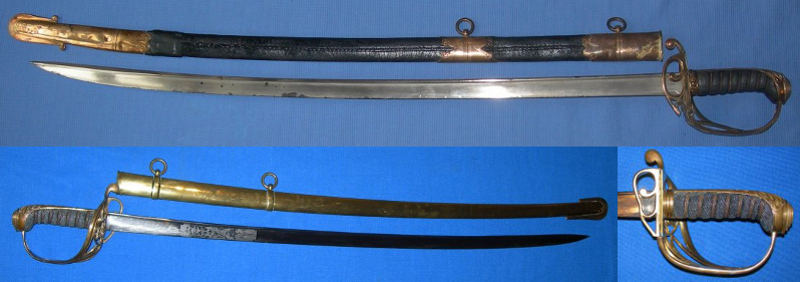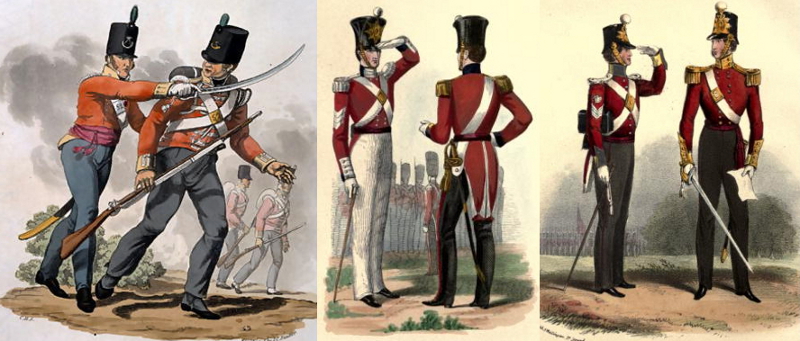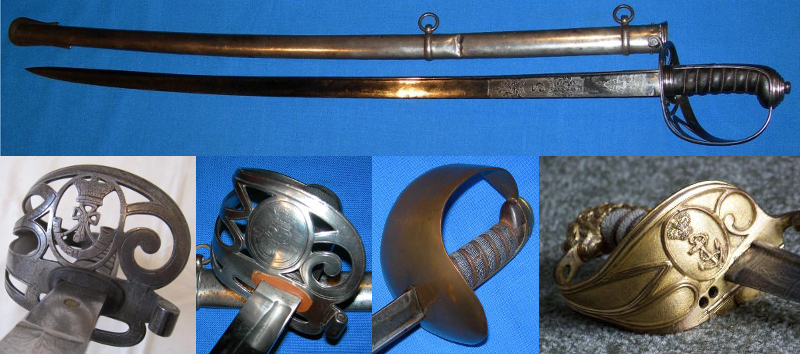We hope you enjoy the articles and short stories presented here, and will join Kate in her adventures for many years to come.
Upon request, you will receive an inscribed copy of Kate Tattersall Adventures in China with every donation of $10 or more plus shipping. Please use the Contact Page to provide your shipping address and we will reply with your total.
As standing armies formed, gentlemen outfitted themselves with whatever weapons they preferred and could afford. The rank and file were provided with arms and uniforms by their parent regiment, often purchased by the commanding officer. Throughout the 17th and 18th centuries armies grew, became more professional, and better equipped. This article will concentrate on the swords of the British Army, from 1780 to the Crimean War (1853–56), because these are weapons Kate Tattersall would have encountered while growing up and on her adventures with the British Secret Service. Note: There were hundreds of variations made by different countries, copying each other, making slight changes, so the features I point out about certain weapons would apply to a similar Prussian model, or Spanish, &c.

28th Foot at Quatre Bras, 16 June 1815, by E. Thompson (1846 – 1933). Formed in square to fend off cavalry, an officer (centre without headdress) uses his sword to point out the next threat to his stoic sergeant. Mounted officers wait at the centre of the formation with the Regimental and King’s Colours, prepared to flee lest the square should fail.
The cumbersome and crude broadswords of old had been displaced with long thin rapiers, the belief being slashes would wound, while thrusts were deadly. Metallurgy in the 1700’s allowed the development of blades which could be effective in both regards, and still be light enough for prolonged use in battle for the average combatant. Swords were crafted for infantry officers, the soldiers carrying musket and bayonet. The exception were the sergeants, who were often issued swords, and drummer boys who were given shortened versions. So, unlike the cavalry sabres that were mass produced for the common troopers, infantry swords were generally made almost exclusively for gentlemen officers.

1780s Infantry Officer’s Spadroon, with 5 ball decorations.
The first attempt at a uniform pattern sword was the British Infantry Officer’s “5 Ball” Spadroon, with usually a 32.5 inch (825 mm) blade, introduced in the 1780’s. The last variant of the this sword was contracted in 1796. A spadroon was a term used in the 18th century to describe a cut and thrust sword. Called the “5-ball” because of the decorations on the cross-guard and knuckle-bow, this pattern proved very popular, and was also carried by sergeants. British officers had countless variations produced, and French and American army officers adopted it and did likewise. Wood grips covered by leather were most common, but also polished wood and ivory models. The French nicknamed it the “epee anglaise” (English sword), mass produced it, and it may have been the most common sword during the French Revolution (1789–99).

1803 Pattern Flank Company Officer’s Sword, it has a George III Royal Cypher and lion head pommel.
While the infantry spadroon had some cut and thrust functionality to it, it was considered inadequate for the flank companies (Grenadier, Light Infantry and Rifle officers of each British Army regiment) who more often experienced hand-to-hand encounters. By the late 1790’s curved bladed infantry sabres started appearing, in many shapes and sizes. In 1803 the Horse Guards took steps to standardize this inconsistency. Britain was at war with France, so many manufacturers were contracted with rush orders, producing countless variations of the 1803 Pattern Infantry Officer’s Sword (1803P), with blades between 31 to 32 inches (785 to 810 mm), and wealthy officers had them modified. All officer’s swords of the era could be as ornate as the owner could afford. Most had the plain effective curved blade of a light cavalry sabre, without engraving, and well fullered*, while others were ridiculously curved, useless, crafted flat, then etched and decorated in vibrant blue and gold gilt. Likely many officers possessed a couple plain sabres for combat, and a decorated show-piece for parades. Grips were usually fashioned with shagreen† or tanned leather over wood, bound with twisted steel wire, but ivory, bone and polished wood were also made. The scabbards were generally leather with decorative hardware, and often with hanging rings and a frog‡ fitting, so it could be worn suspended from a waist or shoulder belt.

1822 Pattern Infantry Officer’s Swords. Note the folding guard feature. Both styles of scabbards are shown here. Variations of leather and metals were used in the crafting of scabbards.
In the 1822 dress regulations mandated the introduction of a new sword, to replace the 1803 flank officer’s sabre and the spadroons. The term “Gothic Hilt” was used to describe the 1822 Pattern Infantry Officer’s Sword (1822P), because of the similarity between the decorative curved bars of the guard and the arches found in Gothic architecture. The guard also featured a hinged portion, allowing the sword to hang close on the hip, then falling into place when the weapon was drawn for combat. Aesthetically pleasing, as a fighting tool they were considered middling. Despite this, the pattern and its many variants remained in service throughout most of the 1800s, finally replaced near the end of the Victorian era in 1897. The sword featured a 32.5 inch (825 mm) slightly curved blade of what was known as the “pipe-back” or “quill-back” design. This consisted of a flat, single edged blade with a nearly straight rod running along the back of the blade, and a “false edge” being formed near to the tip. Combat models were produced with wire bound tanned leather or shagreen covered grips, while parade versions had ivory, polished wood, &c, and fancy scabbards. Tall men, who already had the advantage of a long arm, would have longer blades crafted, adding to their overall reach. Note: Artillery, engineer, and logistics officers wore swords similar to the infantry patterns.

53rd Light Infantry (1812), 86th Foot (1842), and 12th Foot (1848), showing officers with their swords. At least the first two are wearing shoulder belts and have frog attachment points on their scabbards. All the scabbards are leather with brass fittings. Note: Both sergeants are saluting with their left hands. Salutes were carried out with whichever arm was closest to the officer, and not returned, the courtesy being the officer giving the lower rank his attention. Standardized right-handed saluting was established around 1917.
The following infantry weapons were considered variants of the 1822P, and did not replace swords already in service. Officers could “upgrade” to newer patterns if they desired, or when forced to through circumstances. Sometimes old trusted blades would be mated to newer guards, so examples exist of flat pipe-back blades resting in the haft of 1845P or 1854P swords.

Above: 1827 Pattern Rifle Officers Sword. Below: On the left are two 1827 Pattern Rifle Officer’s Sword variants featuring a crown and hung powder horn. There is a 1822P with a practical plain brass bowl, and a Royal Navy model with a lion head pommel on the right.
The 1827 Pattern Rifle Officer’s Swords (1827P) were crafted with steel guards and a crown and hung powder horn cartouche. Within an infantry regiment would be a rifle company of marksmen, specially trained as skirmishers. The “Gothic Hilt” of the 1822P failed in combat, particularly the folding portion, so rifle officers requested the stronger guards. Otherwise, the construction of the swords and scabbards were relatively unchanged from the 1822P, but the most common blade length dropped to 32 inches (810 mm), and some were crafted with fullered blades. Other officers also requested fixed guards, and symmetrical bowl style guards as well. The decoration on the guard (Royal Cypher) of the 1822P changed in 1830, with the crowning of William IV, and again in 1837 when Queen Victoria became sovereign. All variants were produced with wire bound leather or shagreen covered grips, while parade versions had ivory, polished wood, &c, and fancy scabbards. The Admiralty also adopted the 1822P, so Royal Navy officers carried this sword throughout much of the 1800s.

1845 Pattern Infantry Officer’s Sword.
The 1845 Pattern Infantry Officer’s Sword (1845P) was crafted with fullered blades and a flat back. Today these are known as “Wilkinson” style blades, but at the time they were just called “the new” pattern. There are examples with and without the folding guard feature, and the wide variations similar to the 1822P. Again, grips were usually fashioned with shagreen, bound with twisted steel wire, but ivory, bone and polished wood were also made. The scabbards in this era were usually steel or brass (but leather with various metal fitting were also produced) with hanging rings for sword slings on a waist belt, but some still had a frog fitting, so it could be worn suspended from a shoulder belt.

1854 Pattern Infantry Officer’s Sword, the guard detail highlights Queen Victoria’s Royal Cypher.
In 1854 the folding guard and frog fittings were officially discontinued. The gentle curve was replaced by an almost straight fullered blade with symmetrical spear point, providing an ideal thrusting weapon. Ceremonial variants were very straight and tapered. Blade length was usually between 31 to 32 inches (785 to 810 mm). The 1845P and 1854 Infantry Officer’s Swords (1854P) saw extensive service in the Crimean War, India Mutiny and expansion north-west including Afghanistan, China incursions, Zulu Wars, the many Sudan campaigns, and were exported to the Union and Confederate States during the American Civil War. As with every sword listed above, officers possessed a couple plain tools for combat, and a decorated show-piece for parades. Grips were usually fashioned with shagreen bound with twisted steel wire, but ivory, bone and polished wood were also made for dress purposes. Some scabbards were crafted of leather with metal fittings, but most were of steel or brass, and officers sometimes had the hilts and scabbards of their swords silvered as a protection against corrosion associated with rain and high humidity.

1804 Pattern Royal Navy Boarding Cutlass.
In 1804 a new Pattern Royal Navy Boarding Cutlass (1804P) was introduced. Unlike the swords covered above, this was a crude weapon mass produced for the sailors. It saw service in thousands of small actions, and famous battles like Trafalgar (1805) through to the Crimean War, where sailors used the sword on land and sea. (It was not replaced until 1858 with an innovative model that was also a bayonet.) The design of the predecessor had been popular, so the 1804P was basically the same weapon with improvements. The figure ‘8’ iron hilt was retained but the horn or leather grips were done away with, replaced by an iron grip. Yes, the iron was heavy and would rust, but the old grips actually fell apart from exposure to salt water and humidity, forcing the sailors to improvise with rags and cord. The 1804P was extremely cheap and simple, and the Royal Navy produced countless quantities with many variations of blades, surviving examples ranging from 24 to 29 inches (600 to 750 mm). Through the numerous Royal Navy engagements fought around the world as part of the British Empire building, these cutlasses fell into the hands of other navies.
If you would like to examine further images of British swords please consider visiting Antique Swords, where there is also a vast array of weapons from other eras and nations.
Click here to read a similar article about British cavalry sabres.
*Fullered refers to a groove running along the flat of a sword blade. It saved on weight while maintaining strength.
†Shagreen is a word used for various untanned leather (but dyed any colour) with a granular surface, prepared from sharkskin, horsehide, ray, seal, &c, often used for the grips of weapons.
‡Frog in military parlance is a short round sheath of heavy material (leather, canvas, &c) that the scabbard of a long weapon secures into. The scabbard is fashioned with a protruding nub that fits into a corresponding hole on the frog, keeping it from rotating or shifting up and down.
We hope you enjoy the articles and short stories presented here, and will join Kate in her adventures for many years to come.
Upon request, you will receive an inscribed copy of Kate Tattersall Adventures in China with every donation of $10 or more plus shipping. Please use the Contact Page to provide your shipping address and we will reply with your total.

This is absolutely wonderful.
You might enjoy the Victorian Wars Forum (www.victorianwars.com). Here is another concise guide (and not yet complete) to Victorian military swords, with a short list of suggested reading and some history of the development of the infantry sword throughout the period: http://www.victorianwars.com/viewtopic.php?f=21&t=1004
Good stuff, great article, thanks!!!
Beautifully laid out website. Just a tip, if you have your own collection wipe them with gun oil to stop corrosion.
This blog seems to be dedicated to swords sword.